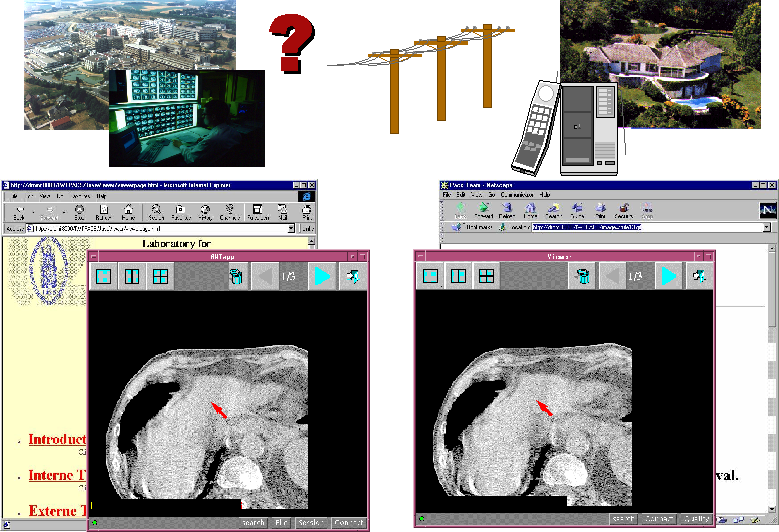
Michel
Feron 1, Erwin Bellon 1, Werner Aerts 1, Joost
Wauters 1, Kris Buggenhout 1,
Andre De Deurwaerder 2, Bart Van den Bosch 2, Guy Marchal
1, Paul Suetens 1
1 Medical Image Computing
(ESAT & Radiology)
2 Department of Information Systems, University Hospitals Leuven
Katholieke Universiteit Leuven, Belgium
Purpose of this work was to develop support for radiological interactive tele-cooperation based on high-end images. However, unlike the situation with many ‘teleradiology’ applications that require the same system to be installed with all participating experts and thus targeted towards closed user groups, we wanted to support ad-hoc cooperation between ‘any’ two or more experts at ‘any’ location.
Until recently, there is a fundamental inconsistency in this idea. In order to be useable by a wide audience, the communication solutions must be very standardized, much like the telephone system. Thus, it would seem reasonable to deploy emerging standard solutions for multimedia tele-interaction such as video conferencing and application sharing. However, at the same time, domain specific data types such as series of radiological images require features that are only provided by specific non-standard applications.
We have experimented with exploiting the World Wide Web paradigm in combination with JAVA applets. The WWW mechanisms provide a standard (and universal availability in principle) at the lower levels. The JAVA applet principle enables us to provide application specific functionality to ‘anyone’ on an ad-hoc basis. Thus, universal access to the application specific functionality is obtained.
The JAVA ‘tele viewer’ applet can be called from within the Web browser of any number of participants at any location (Figure 1). Any participant can initiate a conferencing session that can be joined by any number of other participants. From then on, images loaded in any applet are automatically transmitted to the other connected applets. Image interactions by one participant are reflected in the viewers of all participants connected to the session. Such interactivity may include pointing out structures, real time intensity windowing, navigating through multiple slices (using the traditional stacked or tiled layouts), browsing through image icons, zooming, etc. Actions by different participants are synchronized without a master-slave relationship, much like in a telephone conversation.
While image viewing is synchronized, image loading may be different at the different sites. This allows for example the participant at the central hospital to query the local PACS/HIS database, while other participants may contribute images to the conferencing session by reading them from a local file. In any case, all images, wherever they are imported, are shared. Images that are transmitted between remote sites can be compressed on the fly. Compression/decompression of 12 bit images is supported by invoking native C code for PC or SUN platforms.
Much attention has been spent on design principles and on supporting a reasonable level of efficiency. All synchronization is accomplished by exchanging ‘command objects’ (which are serialized and distributed using OO principles of JAVA). Only those commands that affect the viewer in a significant way are distributed.

Initial technical tests have been performed between different hospitals as an add-hoc addition to an evaluation of video-conferencing. These tests exploited ISDN connections (128 kbit/s).
The principle is evaluated to support consultation between a radiologist on duty in the emergency department of the hospital and a sub specialist who is on call at home. These tests use ISDN as well as ADSL technology, and include provisions for secure communication and secure access to the hospital information system through the Internet.
With all set-ups, there was no need to preinstall any specific application software at the computers of the remote experts.
A presentation at EuroPACS would have two purposes. A first is to illustrate the technical possibilities of WWW/JAVA for a rather demanding application (including some design principles). The second, and most important one, is to discuss how emerging technology will enable us to provide ‘universal availability’ of tele-cooperation methods notwithstanding specific needs for a particular application domain.
Correspondence:
Michel Feron
Medical Image Computing
(ESAT & Radiology)
Katholieke Universiteit Leuven, Belgium
Herestraat 49
B-3000 Leuven, Belgium
Email: michel.feron(at)uz.kuleuven.ac.be
Oral presentation at EuroPACS'98, Barcelona, Spain